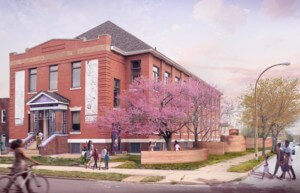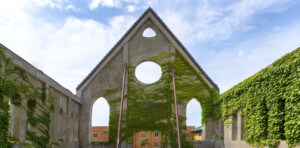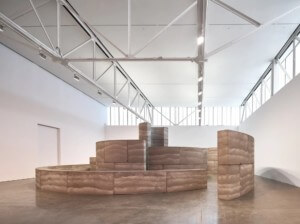Architect and writer Brian Newman recently took a walk through St. Louis’ newest urban park and sent this dispatch.
Before setting foot in St. Louis’ downtown City Garden, which officially opened to the public last week, before you come across the bright red Keith Herring totem or Tom Otterness’ bulbous bronze Gepetto, even before you see its verdant paths and shaded lawns, you see the packs of happily damp children, wrapped in beach towels. There are children everywhere in City Garden, swimming in fountains and splashing under limestone framed waterfalls, playing in front of a huge interactive LED video wall and climbing on any one of the almost two dozen sculptures installed throughout the park.
The City Garden brings to downtown not only an entirely new, and enthusiastic, demographic, but a new formal and aesthetic framework. This isn’t to suggest that before the ribbon was cut and the crowds began exploring the grounds that downtown St. Louis didn’t have green space and sculpture. But the sum of these existing parts seldom congealed into much. City Garden changes that.
Its 2.9 acres offer meandering gravel paths, hills, outlooks, multi-tiered water features, and enough trees to shade a visitor’s stroll virtually from edge to edge.
Designed by Charlottesville, VA landscape architecture firm Nelson Byrd Woltz, and financed locally by the Gateway Foundation, the $25 million park is divided into three distinct latitudinal bands, each taking cues from regional geographic and geological precedents. The Northern River Bluffs band features a chain of terraces topped by an airy grove of willow oak, honey locust, and serviceberry trees, a shallow wading pool and an adjacent glass pavilion which houses the Terrace View restaurant.
An arching limestone wall defines the Middle Flood Plain band, and runs nearly the two-block length of the park. A narrow water basin framed by black granite tile is punctuated by a cascading waterfall at the eastern its end waterfall. Across the park’s central axis, a plaza features 102 in-ground water jets, each of which plays a role in multicolor- and time-coordinated choreography, and is the real epicenter of children’s play.
The Southern River Terrace band separates the City Garden from Market Street and offers an unbroken stretch of Ginkgo trees and an 1,100 foot long granite seat wall that gracefully wends its way across the length of the park. Where the wall bends, small gardens of wildflowers and native grasses appear, providing some relatively secluded seating for visitors who may not be so inclined to explore the park’s many water features.
Sculpture by renowned artists, including Mark di Suvero, Tony Smith, Aristide Maillol and Jim Dine, is liberally installed throughout each of the bands and operate like a series of magnetic poles, pulling the visitor deeper into the park.
Downtown St. Louis has no version of New York’s Broadway to bisect its city blocks at oblique and irregular intervals, producing much needed relief from a relentless street grid. With the opening of City Garden, downtown has found a respite from the strictly orthogonal, an opportunity to take a step away from the rigorous logic of the existing city layout. Its shapes and gestures seem to relate less to the monolithic steel structures directly across the street than to the robust organic forms of Sullivan’s nearby Wainwright Building and the lavishly ornamented City Hall from the late 19th century.
While its forms may be suggestive of a particular era of the past, the attention paid to sustainable planting strategies and responsible material use speaks clearly to our contemporary concerns. City Garden undoubtedly has the capacity to spur economic growth in its immediate vicinity and, perhaps more importantly, it also has the potential to change perceptions about its urban home.










